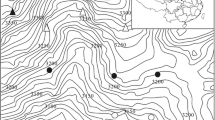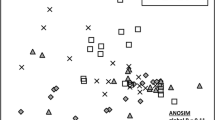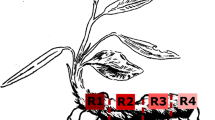Abstract
The community of ectomycorrhizal (ECM) and co-associated fungi from a serpentine site forested with Pinus sylvestris and Quercus petraea was explored, to improve the understanding of ECM diversity in naturally metalliferous soils. ECM fungi were identified by a combination of morphotyping and direct sequencing of the nuclear ribosomal internal transcribed spacer region 2 and of a part of the large-subunit region. Co-associated fungi from selected ECM were identified by restriction fragment length polymorphism and sequencing of representative clones from libraries. Polymerase chain reaction with species-specific primers was applied to assess patterns of association of ECM and co-associated fungi. Twenty ECM species were differentiated. Aphyllophoralean fungi representing several basidiomycete orders and Russulaceae were dominant. Phialocephala fortinii was the most frequently encountered taxon from the diverse assemblage of ECM co-associated fungi. A ribotype representing a deeply branching ascomycete lineage known from ribosomal deoxyribonucleic acid sequences only was detected in some ECM samples. A broad taxonomic range of fungi have the potential to successfully colonise tree roots under the extreme edaphic conditions of serpentine soils. Distribution patterns of ECM-co-associated fungi hint at the importance of specific inter-fungal interactions, which are hypothesised to be a relevant factor for the maintenance of ECM diversity.




Similar content being viewed by others
References
Adriaensen K, Vralstad T, Noben JP, Vangronsveld J, Colpaert JV (2005) Copper-adapted Suillus luteus, a symbiotic solution for pines colonizing Cu mine spoils. Appl Environ Microbiol 71:7279–7284
Adriaensen K, Vangronsveld J, Colpaert JV (2006) Zinc-tolerant Suillus bovinus improves growth of Zn-exposed Pinus sylvestris seedlings. Mycorrhiza 16:553–558
Agerer R (1991) Characterization of ectomycorrhiza. In: Norris JR, Read DJ, Varma AK (eds) Methods Microbiol Techniques for the study of mycorrhiza, 23:25–73
Aggangan NS, Dell B, Malajczuk N (1998) Effects of chromium and nickel on growth of the ectomycorrhizal fungus Pisolithus and formation of ectomycorrhizas on Eucalyptus urophylla S.T. Blake. Geoderma 84:15–27
Altschul SF, Madden TL, Schaffer AA, Zhang J, Zhang Z, Miller W, Lipman DJ (1997) Gapped BLAST and PSI-BLAST: a new generation of protein database search programs. Nucleic Acids Res 25:3389–3402
Amir H, Pineau R (1998) Effects of metals on the germination and growth of fungal isolates from New Caledonian ultramafic soils. Soil Biol Biochem 30:2043–2054
Anderson IC, Campbell CD, Prosser JI (2003) Potential bias of fungal 18S rDNA and internal transcribed spacer polymerase chain reaction primers for estimating fungal biodiversity in soil. Environ Microbiol 5:36–47
Barceloux DG (1999) Nickel. J Toxicol Clin Toxicol 37:239–258
Bellion M, Courbot M, Jacob C, Blaudez D, Chalot M (2006) Extracellular and cellular mechanisms sustaining metal tolerance in ectomycorrhizal fungi. FEMS Microbiol Lett 254:173–181
Berbee ML (2001) The phylogeny of plant and animal pathogens in the Ascomycota. Phys Mol Plant Pathol 59:165–187
Blaudez D, Jacob C, Turnau K, Colpaert JV, Ahonen-Jonnarth U, Finlay R, Botton B, Chalot M (2001) Differential responses of ectomycorrhizal fungi to heavy metals in vitro. Mycol Res 104:1366–1371
Brady KU, Kruckeberg AR, Bradshaw Jr HD (2005) Evolutionary ecology of plant adaptation to serpentine soils. Ann Rev Ecol Evol Syst 36:243–266
Bruns T (1995) Thoughts on the processes that maintain local species diversity of ectomycorrhizal fungi. Plant Soil 170:63–73
Castelli JP, Casper BB (2003) Intraspecific AM fungal variation contributes to plant-fungal feedback in a serpentine grassland. Ecology 84:323–336
Chen DM, Cairney JW (2002) Investigation of the influence of prescribed burning on ITS profiles of ectomycorrhizal and other soil fungi at three Australian sclerophyll forest sites. Mycol Res 106:532–540
Colpaert JV, Muller LAH, Lambaerts M, Adriaensen K, Vangronsveld J (2004) Evolutionary adaptation to Zn toxicity in populations of Suilloid fungi. New Phytol 162:549–559
Courty P-E, Pritsch K, Schloter M, Hartmann A, Garbaye J (2005) Activity profiling of ectomycorrhiza communities in two forest soils using multiple enzymatic tests. New Phytol 167:309–319
Crous PW, Schubert K, Braun U, de Hoog GS, Hocking AD, Shin H-D, Groenewald JZ (2007) Opportunistic, human-pathogenic species in the Herpotrichiellaceae are phenotypically similar to saprobic or phytopathogenic species in the Venturiaceae. Stud Mycol 58:185–217
Danielson RM, Pruden M (1989) The ectomycorrhizal status of urban spruce. Mycology 8:335–341
Denny HJ, Wilkins DA (1987) Zinc tolerance in Betula spp. IV. The mechanism of ectomycorrhizal amelioration of zinc toxicity. New Phytol 106:545–553
di Pietro M, Churin JL, Garbaye J (2007) Differential ability of ectomycorrhizas to survive drying. Mycorrhiza 17:547–550
Dixon RK (1988) Response of ectomycorrhizal Quercus rubra to soil cadmium, nickel and lead. Soil Biol Biochem 20:555–559
Dixon RK, Buschena CA (1988) Response of ectomycorrhizal Pinus banksiana and Picea glauca to heavy metals in soil. Plant Soil 105:265–271
Ernst WHO (2000) Evolution of metal hyperaccumulation and phytoremediation hype. New Phytol 146:357–358
Furnier GR, Adams WT (1986) Geographic patterns of allozyme variation in Jeffrey pine. Am J Bot 73:1009–1015
Gadd GM (1993) Interactions of fungi with toxic metals. New Phytol 124:25–60
Gardes M, Bruns TD (1996) Community structure of ectomycorrhizal fungi in a Pinus muricata forest: above- and below-ground views. Can J Bot 74:1572–1583
Gehring CA, Theimer TC, Whitham TG, Keim P (1998) Ectomycorrhizal fungal community structure of pinyon pines growing in two environmental extremes. Ecol 79:1562–1572
Genney DR, Anderson IC, Alexander IJ (2006) Fine-scale distribution of pine ectomycorrhizas and their extramatrical mycelium. New Phytol 170:381–390
Gonçalves S, Portugal A, Gonçalves M, Vieira R, Martins-Loução M, Freitas H (2007) Genetic diversity and differential in vitro responses to Ni in Cenococcum geophilum isolates from serpentine soils in Portugal. Mycorrhiza 17:677–686
Gorfer M, Klaubauf S, Bandian D, Strauss J (2007) Cadophora finlandia and Phialocephala fortinii: Agrobacterium-mediated transformation and functional GFP-expression. Mycol Res 111:850–855
Grünig CR, McDonald BA, Sieber TN, Rogers SO, Holdenrieder O (2004) Evidence for subdivision of the root-endophyte Phialocephala fortinii into cryptic species and recombination within species. Fungal Genet Biol 41:676–687
Grünig CR, Duo A, Sieber TN (2006) Population genetic analysis of Phialocephala fortinii s.l. and Acephala applanata in two undisturbed forests in Switzerland and evidence for new cryptic species. Fungal Genet Biol 43:410–421
Hartley J, Cairney JWG, Meharg AA (1997) Do ectomycorrhizal fungi exhibit adaptive tolerance to potentially toxic metals in the environment? Plant Soil 189:303–319
Huber T, Faulkner G, Hugenholtz P (2004) Bellerophon: a program to detect chimeric sequences in multiple sequence alignments. Bioinformatics 20:2317–2319
Ishida TA, Nara K, Hogetsu T (2007) Host effects on ectomycorrhizal fungal communities: insight from eight host species in mixed conifer–broadleaf forests. New Phytol 174:430–440
Izzo A, Agbowo J, Bruns TD (2005) Detection of plot-level changes in ectomycorrhizal communities across years in an old-growth mixed-conifer forest. New Phytol 166:619–630
Jones MD, Hutchinson TC (1986) The effect of mycorrhizal infection on the response of Betula papyrifera to nickel and copper. New Phytol 102:429–442
Jones MD, Hutchinson TC (1988) Nickel toxicity in mycorrhizal birch seedlings infected with Lactarius rufus or Scleroderma flavidum. I. Effects on growth, photosynthesis, respiration and transpiration. New Phytol 108:451–459
Jonsson L, Dahlberg A, Nilsson M-C, Zackrisson O, Karen OLA (1999) Ectomycorrhizal fungal communities in late-successional Swedish boreal forests, and their composition following wildfire. Mol Ecol 8:205–215
Jumpponen A, Johnson LC (2005) Can rDNA analyses of diverse fungal communities in soil and roots detect effects of environmental manipulations—a case study from tallgrass prairie. Mycology 97:1177–1194
Jumpponen A, Trappe JM (1998a) Dark septate endophytes: a review of facultative biotrophic root-colonizing fungi. New Phytol 140:295–310
Jumpponen A, Trappe JM (1998b) Performance of Pinus contorta inoculated with two strains of root endophytic fungus, Phialocephala fortinii: effects of synthesis system and glucose concentration. Can J Bot 76:1205–1213
Kaldorf M, Renker C, Fladung M, Buscot F (2004) Characterization and spatial distribution of ectomycorrhizas colonizing aspen clones released in an experimental field. Mycorrhiza 14:295–306
Kalendar R (2006) FastPCR: a PCR primer design and repeat sequence searching software with additional tools for the manipulation and analysis of DNA and protein. www.biocenter.helsinki.fi/bi/programs/fastpcr.htm
Katoh K, Kuma K-i, Toh H, Miyata T (2005) MAFFT version 5: improvement in accuracy of multiple sequence alignment. Nucleic Acids Res 33:511–518
Kayama M, Choi D, Tobita H, Utsugi H, Kitao M, Maruyama Y, Nomura M, Koike T (2006) Comparison of growth characteristics and tolerance to serpentine soil of three ectomycorrhizal spruce seedlings in northern Japan. Trees Struct Funct 20:430–440
Koide RT, Xu B, Sharda J (2005a) Contrasting below-ground views of an ectomycorrhizal fungal community. New Phytol 166:251–262
Koide RT, Xu B, Sharda J, Lekberg Y, Ostiguy N (2005b) Evidence of species interactions within an ectomycorrhizal fungal community. New Phytol 165:305–316
Korkama T, Pakkanen A, Pennanen T (2006) Ectomycorrhizal community structure varies among Norway spruce (Picea abies) clones. New Phytol 171:815–824
Kruckeberg A (1967) Ecotypic response to ultramafic soils by some plant species of northwestern United States. Brittonia 19:133–151
Krupa P, Kozdrój J (2007) Ectomycorrhizal fungi and associated bacteria provide protection against heavy metals in inoculated pine (Pinus sylvestris L.) seedlings. Water Air Soil Pollut 182:83–90
Landeweert R, Leeflang P, Smit E, Kuyper T (2005) Diversity of an ectomycorrhizal fungal community studied by a root tip and total soil DNA approach. Mycorrhiza 15:1–6
Leyval C, Turnau K, Haselwandter K (1997) Effect of heavy metal pollution on mycorrhizal colonization and function: Physiological, ecological and applied aspects. Mycorrhiza 7:139–153
Ludwig W, Strunk O, Westram R, Richter L, Meier H, Yadhukumar, Buchner A, Lai T, Steppi S, Jobb G, Forster W, Brettske I, Gerber S, Ginhart AW, Gross O, Grumann S, Hermann S, Jost R, Konig A, Liss T, Lussmann R, May M, Nonhoff B, Reichel B, Strehlow R, Stamatakis A, Stuckmann N, Vilbig A, Lenke M, Ludwig T, Bode A, Schleifer K-H (2004) ARB: a software environment for sequence data. Nucleic Acids Res 32:1363–1371
Markkola AM, Ahonen JU, Roitto M, Strommer R, Hyvarinen M (2002) Shift in ectomycorrhizal community composition in Scots pine (Pinus sylvestris L.) seedling roots as a response to nickel deposition and removal of lichen cover. Environ Pollut 120:797–803
Marschner H (1995) Mineral nutrition of higher plants. Academic, London
Marschner H, Dell B (1994) Nutrient uptake in mycorrhizal symbiosis. Plant Soil 159:89–102
Meharg A, Cairney J (2000) Co-evolution of mycorrhizal symbionts and their hosts to metal-contaminated environments. Adv Ecol Res 30:69–112
Menkis A, Vasiliauskas R, Taylor A, Stenlid J, Finlay R (2005) Fungal communities in mycorrhizal roots of conifer seedlings in forest nurseries under different cultivation systems, assessed by morphotyping, direct sequencing and mycelial isolation. Mycorrhiza 16:33–41
Miller SP, Cumming JR (2000) Effects of serpentine soil factors on Virginia pine (Pinus virginiana) seedlings. Tree Physiol 20:1129–1135
Moser AM, Petersen CA, D’Allura JA, Southworth D (2005) Comparison of ectomycorrhizas of Quercus garryana (Fagaceae) on serpentine and non-serpentine soils in southwestern Oregon. Am J Bot 92:224–230
Murat C, Vizzini A, Bonfante P, Mello A (2005) Morphological and molecular typing of the below-ground fungal community in a natural Tuber magnatum truffle-ground. FEMS Microbiol Lett 245:307–313
O’Brien HE, Parrent JL, Jackson JA, Moncalvo J-M, Vilgalys R (2005) Fungal community analysis by large-scale sequencing of environmental samples. Appl Environ Microbiol 71:5544–5550
Oline DK, Mitton JB, Grant MC (2000) Population and subspecific genetic differentiation in the foxtail pine (Pinus balfouriana). Evol 54:1813–1819
Panaccione D, Sheets N, Miller S, Cumming J (2001) Diversity of Cenococcum geophilum isolates from serpentine and non-serpentine soils. Mycol 93:645–652
Porter TM, Schadt CW, Rizvi L, Martin AP, Schmidt SK, Scott-Denton L, Vilgalys R, Moncalvo JM (2008) Widespread occurrence and phylogenetic placement of a soil clone group adds a prominent new branch to the fungal tree of life. Mol Phylogenet Evol 46:635–644
Pringle A, Moncalvo JM, Vilgalys R (2000) High levels of variation in ribosomal DNA sequences within and among spores of a natural population of the arbuscular mycorrhizal fungus Acaulospora colossica. Mycology 92:259–268
Rosling A, Landeweert R, Lindahl BD, Larsson KH, Kuyper TW, Taylor AFS, Finlay RD (2003) Vertical distribution of ectomycorrhizal fungal taxa in a podzol soil profile. New Phytol 159:775–783
Schadt CW, Martin AP, Lipson DA, Schmidt SK (2003) Seasonal dynamics of previously unknown fungal lineages in tundra soils. Science 301:1359–1361
Sen R (2001) Multitrophic interactions between a Rhizoctonia sp. and mycorrhizal fungi affect Scots pine seedling performance in nursery soil. New Phytol 152:543–553
Smit E, Veenman C, Baar J (2003) Molecular analysis of ectomycorrhizal basidiomycete communities in a Pinus sylvestris L. stand reveals long-term increased diversity after removal of litter and humus layers. FEMS Microbiol Ecol 45:49–57
Stamatakis A (2006) RAxML-VI-HPC: maximum likelihood-based phylogenetic analyses with thousands of taxa and mixed models. Bioinformatics 22:2688–2690
Summerbell RC (2005) Root endophyte and mycorrhizosphere fungi of black spruce, Picea mariana, in a boreal forest habitat: influence of site factors on fungal distributions. Stud Mycol 53:121–145
Suresh B, Ravishankar G (2004) Phytoremediation—a novel and promising approach for environmental clean-up. Crit Rev Biotech 24:97–124
Taylor DL, Bruns TD (1999) Community structure of ectomycorrhizal fungi in a Pinus muricata forest: minimal overlap between the mature forest and resistant propagule communities. Mol Ecol 8:1837–1850
Tedersoo L, Hansen K, Perry BA, Kjoller R (2006) Molecular and morphological diversity of pezizalean ectomycorrhiza. New Phytol 170:581–596
Thompson JD, Gibson TJ, Plewniak F, Jeanmougin F, Higgins DG (1997) The ClustalX windows interface: flexible strategies for multiple sequence alignment aided by quality analysis tools. Nucleic Acids Res 24:4876–4882
Turnau K, Przybylowicz WJ, Mesjasz-Przybylowicz J (2001) Heavy metal distribution in Suillus luteus mycorrhizas—as revealed by micro-PIXE analysis. Nucl Instrum Methods Phys Res B 181:649–658
Urban A, Weiss M, Bauer R (2003) Ectomycorrhizae involving sebacinoid mycobionts. Mycol Res 107:3–1
Vralstad T, Myhre E, Schumacher T (2002) Molecular diversity and phylogenetic affinities of symbiotic root-associated ascomycetes of the Helotiales in burnt and metal polluted habitats. New Phytol 155:131–148
Wenzel WW, Jockwer F (1999) Accumulation of heavy metals in plants grown on mineralised soils of the Austrian Alps. Environ Pollut 104:145–155
Wenzel WW, Bunkowski M, Puschenreiter M, Horak O (2003) Rhizosphere characteristics of indigenously growing nickel hyperaccumulator and excluder plants on serpentine soil. Environ Pollut 123:131–138
Wilcox HE, Wang CJK (1987) Mycorrhizal and pathological associations of dematiaceous fungi in roots of 7-month-old tree seedlings. Can J Forest Res 17:884–899
Wilkinson D, Dickinson N (1995) Metal resistance in trees: The role of mycorrhizae. Oikos 72:298–300
Wright J (2007) Local adaptation to serpentine soils in Pinus ponderosa. Plant Soil 293:209–217
Acknowledgements
This work was supported by grant P15357 from the Austrian Science Foundation (FWF) and grant LS149 from the Vienna Science and Technology Fund (WWTF) to JS. The authors thank Anton Russell and two anonymous reviewers for critical reading of the manuscript and helpful suggestions.
Author information
Authors and Affiliations
Corresponding author
Electronic supplementary material
Below is the link to the electronic supplementary material.
Table S1
Comparison of ITS sequences from P. fortinii CSP. P. fortinii ITS sequences from Redlschlag and from Zürichberg (Grünig et al. 2004) were aligned with the ClustalW algorithm. Only positions with differences are shown with discriminating nucleotides highlighted in bold. Numbering of positions is according to sequence AY347406 (CSP3, strain 144-4). Classification into CSP is according to Grünig et al. (2004). Missing characters indicate missing sequence information, and ‘–’ indicates a gap. The poly-T stretch with variable length at the end of the ITS2-region (starting at position 500 in AY347406) is not included in the comparison. #: number of sequences with 100% identity from the Zürichberg sequence set (Grünig et al. 2004) (DOC 143 KB)
Fig. S1
Phylogenetic tree for RSEM01_13 based on partial 18S rDNA sequences. A multiple alignment of a set of published partial 18S rDNA sequences from all recognised groups of fungi including a set of 18S rDNA sequences from AG1 was generated with the ClustalW algorithm in ARB. For construction of the phylogenetic tree, the Phylip package in ARB was used with a filter for positions covered by sequences from the unknown ascomycete lineage. Entomophaga conglomerata was used as the out-group for routing. Branches were collapsed for phyla, except for ascomycota, where branches were collapsed for sub-phyla (shaded triangles). The order Mucorales was separated from the remaining zygomycota. The phyla of chytridiomycota and zygomycota could not be separated based on partial 18S rDNA sequences. Separation of a group of hitherto uncultivated fungi—Ascomycota Group I (darkly shaded triangle)—including the enigmatic ascomycete RSEM01_13 was supported by different algorithms used for construction of the tree (neighbour joining, Bayesian analysis). Numbers inside or next to triangles indicate number of species included in the collapsed branch (PDF 9.23 KB)
Rights and permissions
About this article
Cite this article
Urban, A., Puschenreiter, M., Strauss, J. et al. Diversity and structure of ectomycorrhizal and co-associated fungal communities in a serpentine soil. Mycorrhiza 18, 339–354 (2008). https://doi.org/10.1007/s00572-008-0189-y
Received:
Accepted:
Published:
Issue Date:
DOI: https://doi.org/10.1007/s00572-008-0189-y




